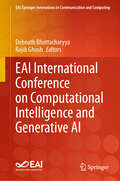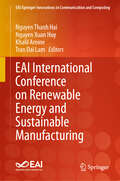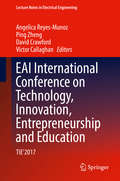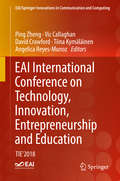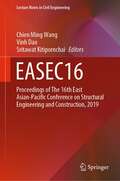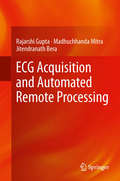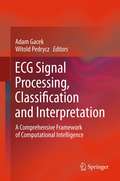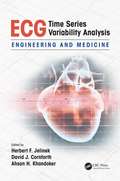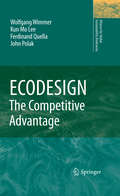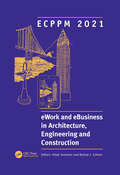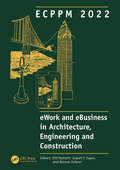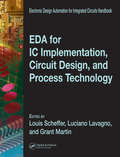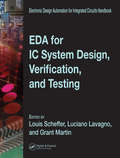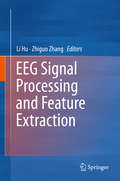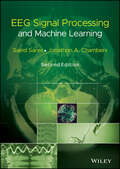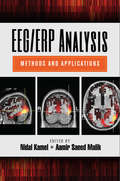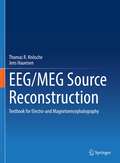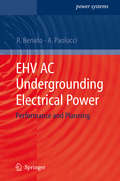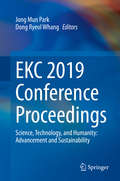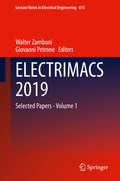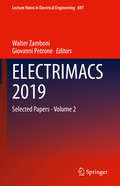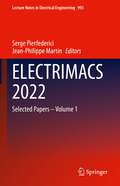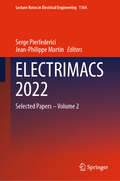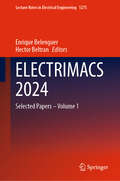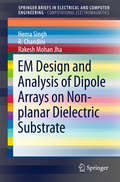- Table View
- List View
EAI International Conference on Computational Intelligence and Generative AI (EAI/Springer Innovations in Communication and Computing)
by Debnath Bhattacharyya Rajib GhoshThe book presents the proceedings of the EAI International Conference on Computational Intelligence and Generative AI (ICCIGAI 2024), which took place March 8-9, 2024, in Guntur, India. The book explores the exciting and rapidly evolving field of artificial intelligence, with a specific focus on computational intelligence and generative models. The conference introduces cutting-edge techniques and methodologies that enable machines to simulate human-like intelligence and creativity. Readers can find a comprehensive overview of state-of-the-art AI methods, including neural networks, evolutionary algorithms, deep learning, and generative adversarial networks (GANs). The conference explores real-world applications in a range of areas, including computer vision, natural language processing, and the creation of original content.
EAI International Conference on Renewable Energy and Sustainable Manufacturing (EAI/Springer Innovations in Communication and Computing)
by Nguyen Thanh Hai Nguyen Xuan Huy Khalil Amine Tran Dai LamThis book presents the proceedings of the EAI International Conference on Renewable Energy and Sustainable Manufacturing (ICRESM 2023), which took place in Ho Chi Minh City, Vietnam, December 16-17, 2023. The conference serves as a platform for researchers, practitioners, industry experts, policymakers, and stakeholders to share their latest findings, innovations, and best practices in the areas of sustainable practices and technologies that reduce reliance on non-renewable resources and encourage the impacts of smart industry 4.0. The papers address global challenges relating to the sustainable manufacturing, energy security and green technologies, and discuss applications that aid in lowering carbon emissions, preserving the environment, and fostering economic growth by supporting renewable energy and eco-friendly manufacturing. Together, the participants disseminate the latest technological advancements, processes, and strategies that promote renewable energy and sustainable manufacturing.
EAI International Conference on Technology, Innovation, Entrepreneurship and Education: TIE'2017 (Lecture Notes in Electrical Engineering #532)
by David Crawford Victor Callaghan Angelica Reyes-Munoz Ping ZhengThis book presents the proceedings of the 1st EAI International Conference on Technology, Innovation, Entrepreneurship and Education (TIE 2017), which took place at Canterbury Christ Church University on September 11-12, 2017. The central theme of the conference is creativity and innovation, especially in relation to technology, business, education, social and political needs that make modern society flourish. The proceedings feature papers from a cross-disciplinary audience that explore the process of creativity and innovation. The goal is that the various disciplines can learn from each other and see how they might benefit from the cross-fertilization of practices.
EAI International Conference on Technology, Innovation, Entrepreneurship and Education: TIE'2018 (Lecture Notes in Electrical Engineering #532)
by David Crawford Angelica Reyes-Munoz Ping Zheng Vic Callaghan Tiina KymäläinenThis book presents the proceedings of the 2nd EAI International Conference on Technology, Innovation, Entrepreneurship and Education (TIE' 2018), which took place at Ravensbourne University London, London, UK, on September 4, 2018. The central theme of the conference is emerging technologies in relation to business, education, social and political needs that make modern society flourish. The proceedings feature papers from a cross-disciplinary audience that explore the process of creativity and innovation. The goal is that the various disciplines can learn from each other and see how they might benefit from the cross-fertilization of practices.
EASEC16: Proceedings of The 16th East Asian-Pacific Conference on Structural Engineering and Construction, 2019 (Lecture Notes in Civil Engineering #101)
by Chien Ming Wang Sritawat Kitipornchai Vinh DaoThis book presents articles from The 16th East Asian-Pacific Conference on Structural Engineering and Construction, 2019, held in Brisbane, Australia. It provides a forum for professional engineers, academics, researchers and contractors to present recent research and developments in structural engineering and construction.
ECG Acquisition and Automated Remote Processing
by Rajarshi Gupta Madhuchhanda Mitra Jitendranath BeraThe book is focused on the area of remote processing of ECG in the context of telecardiology, an emerging area in the field of Biomedical Engineering Application. Considering the poor infrastructure and inadequate numbers of physicians in rural healthcare clinics in India and other developing nations, telemedicine services assume special importance. Telecardiology, a specialized area of telemedicine, is taken up in this book considering the importance of cardiac diseases, which is prevalent in the population under discussion. The main focus of this book is to discuss different aspects of ECG acquisition, its remote transmission and computerized ECG signal analysis for feature extraction. It also discusses ECG compression and application of standalone embedded systems, to develop a cost effective solution of a telecardiology system.
ECG Signal Processing, Classification and Interpretation
by Adam Gacek Witold PedryczThe book shows how the various paradigms of computational intelligence, employed either singly or in combination, can produce an effective structure for obtaining often vital information from ECG signals. The text is self-contained, addressing concepts, methodology, algorithms, and case studies and applications, providing the reader with the necessary background augmented with step-by-step explanation of the more advanced concepts. It is structured in three parts: Part I covers the fundamental ideas of computational intelligence together with the relevant principles of data acquisition, morphology and use in diagnosis; Part II deals with techniques and models of computational intelligence that are suitable for signal processing; and Part III details ECG system-diagnostic interpretation and knowledge acquisition architectures. Illustrative material includes: brief numerical experiments; detailed schemes, exercises and more advanced problems.
ECG Time Series Variability Analysis: Engineering and Medicine
by Herbert F. Jelinek David J. Cornforth Ahsan H. KhandokerDivided roughly into two sections, this book provides a brief history of the development of ECG along with heart rate variability (HRV) algorithms and the engineering innovations over the last decade in this area. It reviews clinical research, presents an overview of the clinical field, and the importance of heart rate variability in diagnosis. The book then discusses the use of particular ECG and HRV algorithms in the context of clinical applications.
ECODESIGN -- The Competitive Advantage
by Kun Mo Lee Wolfgang Wimmer Ferdinand Quella John PolakThis volume deals with the new EuP-directive of the European Union forcing manufacturers of electronic equipment to consider Ecodesign in their product development. Selling electronic equipment in the EU will require conformity assessment with the new EuP-directive currently under development. The conformity will be expressed by the mandatory CE-marking.
ECPPM 2021 - eWork and eBusiness in Architecture, Engineering and Construction: Proceedings of the 13th European Conference on Product & Process Modelling (ECPPM 2021), 5-7 May 2021, Moscow, Russia
by Vitaly SemenoveWork and eBusiness in Architecture, Engineering and Construction 2021 collects the papers presented at the 13th European Conference on Product and Process Modelling (ECPPM 2021, Moscow, 5-7 May 2021). The contributions cover a wide spectrum of thematic areas that hold great promise towards the advancement of research and technological development targeted at the digitalization of the AEC/FM (Architecture, Engineering, Construction and Facilities Management) domains. High quality contributions are devoted to critically important problems that arise, including: Information and Knowledge Management Semantic Web and Linked Data Communication and Collaboration Technologies Software Interoperability BIM Servers and Product Lifecycle Management Systems Digital Twins and Cyber-Physical Systems Sensors and Internet of Things Big Data Artificial and Augmented Intelligence in AEC Construction Management 5D/nD Modelling and Planning Building Performance Simulation Contract, Cost and Risk Management Safety and Quality Sustainable Buildings and Urban Environments Smart Buildings and Cities BIM Standardization, Implementation and Adoption Regulatory and Legal Aspects BIM Education and Training Industrialized Production, Smart Products and Services Over the past quarter century, the biennial ECPPM conference series, as the oldest BIM conference, has provided researchers and practitioners with a unique platform to present and discuss the latest developments regarding emerging BIM technologies and complementary issues for their adoption in the AEC/FM industry.
ECPPM 2022 - eWork and eBusiness in Architecture, Engineering and Construction 2022: Proceedings of the 14th European Conference on Product and Process Modelling (ECPPM 2022), September 14-16, 2022, Trondheim, Norway.
by Raimar J. Scherer Eilif Hjelseth Sujesh F. SujanECPPM 2022 - eWork and eBusiness in Architecture, Engineering and Construction contains the papers presented at the 14th European Conference on Product & Process Modelling (ECPPM 2022, Trondheim, Norway, 14-16 September 2022), and builds on a long-standing history of excellence in product and process modelling in the construction industry, which is currently known as Building Information Modelling (BIM). The following topics and applications are given special attention: Sustainable and Circular Driven Digitalisation: Data Driven Design and/or Decision Support Assessment and Documentation of Sustainability Information lifecycle Data Management: Collection, Processing and Presentation of Environmental Product Documentation (EPD) and Product Data Templates (PDT) Digital Enabled Collaboration: Integrated and Multi-Disciplinary Processes Virtual Design and Construction (VDC): Production Metrics, Integrated Concurrent Engineering, Lean Construction and Information Integration Automation of Processes: Automation of Design and Engineering Processes, Parametric Modelling and Robotic Process Automation Expert Systems: BIM based model and compliance checking Enabling Technologies: Machine Learning, Big Data, Artificial and Augmented Intelligence, Digital Twins, Semantic Technology Sensors and IoT Production with Autonomous Machinery, Robotics and Combinations of Existing and New Technical Solutions Frameworks for Implementation: International Information Management Series (ISO 19650), and Other International Standards (ISO), European (CEN) and National Standards, Digital Platforms and Ecosystems Human Factors in Digital Application: Digital Innovation, Economy of Digitalisation, Client, Organisational, Team and/or Individual Perspectives Over the past 25 years, the biennial ECPPM conference proceedings series has provided researchers and practitioners with a unique platform to present and discuss the latest developments regarding emerging BIM technologies and complementary issues for their adoption in the AEC/FM industry.
EDA for IC Implementation, Circuit Design, and Process Technology (Electronic Design Automation for Integrated Circuits Hdbk)
by Grant Martin Luciano Lavagno Louis SchefferPresenting a comprehensive overview of the design automation algorithms, tools, and methodologies used to design integrated circuits, the Electronic Design Automation for Integrated Circuits Handbook is available in two volumes. The second volume, EDA for IC Implementation, Circuit Design, and Process Technology, thoroughly examines real-time logic to GDSII (a file format used to transfer data of semiconductor physical layout), analog/mixed signal design, physical verification, and technology CAD (TCAD). Chapters contributed by leading experts authoritatively discuss design for manufacturability at the nanoscale, power supply network design and analysis, design modeling, and much more. Save on the complete set.
EDA for IC System Design, Verification, and Testing (Electronic Design Automation for Integrated Circuits Hdbk)
by Louis Scheffer, Luciano Lavagno and Grant MartinPresenting a comprehensive overview of the design automation algorithms, tools, and methodologies used to design integrated circuits, the Electronic Design Automation for Integrated Circuits Handbook is available in two volumes. The first volume, EDA for IC System Design, Verification, and Testing, thoroughly examines system-level design, microarchitectural design, logical verification, and testing. Chapters contributed by leading experts authoritatively discuss processor modeling and design tools, using performance metrics to select microprocessor cores for IC designs, design and verification languages, digital simulation, hardware acceleration and emulation, and much more. Save on the complete set.
EEG Signal Processing and Feature Extraction
by Li Hu Zhiguo ZhangThis book presents the conceptual and mathematical basis and the implementation of both electroencephalogram (EEG) and EEG signal processing in a comprehensive, simple, and easy-to-understand manner. EEG records the electrical activity generated by the firing of neurons within human brain at the scalp. They are widely used in clinical neuroscience, psychology, and neural engineering, and a series of EEG signal-processing techniques have been developed. Intended for cognitive neuroscientists, psychologists and other interested readers, the book discusses a range of current mainstream EEG signal-processing and feature-extraction techniques in depth, and includes chapters on the principles and implementation strategies.
EEG Signal Processing and Machine Learning
by Saeid Sanei Jonathon A. ChambersExplore cutting edge techniques at the forefront of electroencephalogram research and artificial intelligence from leading voices in the field The newly revised Second Edition of EEG Signal Processing and Machine Learning delivers an inclusive and thorough exploration of new techniques and outcomes in electroencephalogram (EEG) research in the areas of analysis, processing, and decision making about a variety of brain states, abnormalities, and disorders using advanced signal processing and machine learning techniques. The book content is substantially increased upon that of the first edition and, while it retains what made the first edition so popular, is composed of more than 50% new material. The distinguished authors have included new material on tensors for EEG analysis and sensor fusion, as well as new chapters on mental fatigue, sleep, seizure, neurodevelopmental diseases, BCI, and psychiatric abnormalities. In addition to including a comprehensive chapter on machine learning, machine learning applications have been added to almost all the chapters. Moreover, multimodal brain screening, such as EEG-fMRI, and brain connectivity have been included as two new chapters in this new edition. Readers will also benefit from the inclusion of: A thorough introduction to EEGs, including neural activities, action potentials, EEG generation, brain rhythms, and EEG recording and measurement An exploration of brain waves, including their generation, recording, and instrumentation, including abnormal EEG patterns and the effects of ageing and mental disorders A treatment of mathematical models for normal and abnormal EEGs Discussions of the fundamentals of EEG signal processing, including statistical properties, linear and nonlinear systems, frequency domain approaches, tensor factorization, diffusion adaptive filtering, deep neural networks, and complex-valued signal processing Perfect for biomedical engineers, neuroscientists, neurophysiologists, psychiatrists, engineers, and students and researchers in the above areas, the Second Edition of EEG Signal Processing and Machine Learning will also earn a place in the libraries of undergraduate and postgraduate Biomedical Engineering and Neuroscience, including Epileptology, students.
EEG/ERP Analysis: Methods and Applications
by Nidal Kamel Aamir Saeed MalikChanges in the neurological functions of the human brain are often a precursor to numerous degenerative diseases. Advanced EEG systems and other monitoring systems used in preventive diagnostic procedures incorporate innovative features for brain monitoring functions such as real-time automated signal processing techniques and sophisticated amplifi
EEG/MEG Source Reconstruction: Textbook for Electro-and Magnetoencephalography
by Jens Haueisen Thomas R. KnöscheThis textbook provides a comprehensive and didactic introduction from the basics to the current state of the art in the field of EEG/MEG source reconstruction. Reconstructing the generators or sources of electroencephalographic and magnetoencephalographic (EEG/MEG) signals is an important problem in basic neuroscience as well as clinical research and practice. Over the past few decades, an entire theory, together with a whole collection of algorithms and techniques, has developed. In this textbook, the authors provide a unified perspective on a broad range of EEG/MEG source reconstruction methods, with particular emphasis on their respective assumptions about sources, data, head tissues, and sensor properties. An introductory chapter highlights the concept of brain imaging and the particular importance of the neuroelectromagnetic inverse problem. This is followed by an in-depth discussion of neural information processing and brain signal generation and an introduction to the practice of data acquisition. Next, the relevant mathematical models for the sources of EEG and MEG are discussed in detail, followed by the neuroelectromagnetic forward problem, that is, the prediction of EEG or MEG signals from those source models, using biophysical descriptions of the head tissues and the sensors. The main part of this textbook is dedicated to the source reconstruction methods. The authors present a theoretical framework of the neuroelectromagnetic inverse problem, centered on Bayes’ theorem, which then serves as the basis for a detailed description of a large variety of techniques, including dipole fit methods, distributed source reconstruction, spatial filters, and dynamic source reconstruction methods. The final two chapters address the important topic of assessment, including verification and validation of source reconstruction methods, and their actual application to real-world scientific and clinical questions.This book is intended as basic reading for anybody who is engaged with EEG/MEG source reconstruction, be it as a method developer or as a user, including advanced undergraduate students, PhD students, and postdocs in neuroscience, biomedical engineering, and related fields.
EHV AC Undergrounding Electrical Power
by Antonio Paolucci Roberto Benato"EHV AC Undergrounding Electrical Power" discusses methods of analysis for cable performance and for the behaviour of cable, mixed and overhead lines. The authors discuss the undergrounding of electrical power and develop procedures based on the standard equations of transmission lines. They also provide technical and economical comparisons of a variety of cables and analysis methods, in order to examine the performance of AC power transmission systems. A range of topics are covered, including: energization and de-energization phenomena of transmission lines; power quality; and cable safety constraints. "EHV AC Undergrounding Electrical Power" is a guide to cable insertion planning and the operation of power networks. It will enable readers to make performance comparisons between power transmission systems, which will be valuable for postgraduates, as well as engineers involved in power cable manufacturing or electrical transmission systems.
EKC 2019 Conference Proceedings: Science, Technology, and Humanity: Advancement and Sustainability
by Jong Mun Park Dong Ryeol WhangThis volume offers a selection of papers presented at the Europe-Korea Conference on Science and Technology 2019 (EKC 2019). EKC is a multi/inter/transdisciplinary conference covering all fields of science and technology, aiming to facilitate networking and collaboration between academic and industrial researchers involved in R&D, engineering, manufacturing, and application. The scope is broad, with topics covered including physics and mathematics; chemistry, materials and chemical engineering; biology, bioengineering and medical science; Earth science and environmental engineering; architecture, civil and ocean engineering; electrical, electronic, and informational engineering; mechanical, aerospace, naval, and nuclear engineering; and social science.This book showcases a selection of peer-reviewed, high-impact research results which will be of interest to a wide audience.
ELECTRIMACS 2019: Selected Papers - Volume 1 (Lecture Notes in Electrical Engineering #604)
by Giovanni Petrone Walter ZamboniThis book collects a selection of papers presented at ELECTRIMACS 2019, the 13th international conference of the IMACS TC1 Committee, held in Salerno, Italy, on 21st-23rd May 2019. The conference papers deal with modelling, simulation, analysis, control, power management, design optimization, identification and diagnostics in electrical power engineering. The main application fields include electric machines and electromagnetic devices, power electronics, transportation systems, smart grids, electric and hybrid vehicles, renewable energy systems, energy storage, batteries, supercapacitors and fuel cells, and wireless power transfer. The contributions included in Volume 1 are particularly focused on electrical engineering simulation aspects and innovative applications.
ELECTRIMACS 2019: Selected Papers - Volume 2 (Lecture Notes in Electrical Engineering #697)
by Giovanni Petrone Walter ZamboniThis book collects a selection of papers presented at ELECTRIMACS 2019 - The 13th international conference of the IMACS TC1 Committee, held in Salerno, Italy, on 21st-23rd May 2019. The conference papers deal with modelling, simulation, analysis, control, power management, design optimization, identification and diagnostics in electrical power engineering. The main application fields include electric machines and electromagnetic devices, power electronics, transportation systems, smart grids, electric and hybrid vehicles, renewable energy systems, energy storage, batteries, supercapacitors and fuel cells, wireless power transfer. The contributions included in Volume 2 are particularly focussed on methodological aspects, modelling and applied mathematics in the field of electrical engineering.
ELECTRIMACS 2022: Selected Papers – Volume 1 (Lecture Notes in Electrical Engineering #993)
by Serge Pierfederici Jean-Philippe MartinThis book collects a selection of papers presented at ELECTRIMACS 2021, the 14th international conference of the IMACS TC1 Committee, held in Nancy, France, on 16th-19th May 2022. The conference papers deal with modelling, simulation, analysis, control, power management, design optimization, identification and diagnostics in electrical power engineering. The main application fields include electric machines and electromagnetic devices, power electronics, transportation systems, smart grids, renewable energy systems, energy storage like batteries and supercapacitors, fuel cells, and wireless power transfer. The contributions included in Volume 1 will be particularly focused on electrical engineering simulation aspects and innovative applications.
ELECTRIMACS 2022: Selected Papers – Volume 2 (Lecture Notes in Electrical Engineering #1164)
by Serge Pierfederici Jean-Philippe MartinThis book collects a selection of papers presented at ELECTRIMACS, 2022 the14th international conference of the IMACS TC1 Committee, held in Nancy, France, on 17st-21rd May 2022. The conference papers deal with modelling, simulation, analysis, control, power management, design optimization, identification and diagnostics in electrical power engineering. The main application fields include electric machines and electromagnetic devices, power electronics, transportation systems, smart grids, electric and hybrid vehicles, renewable energy systems, energy storage, batteries, supercapacitors and fuel cells, and wireless power transfer. The contributions included in Volume 2 are particularly focused on methodological aspects, modelling, and applied mathematics in the field of electrical engineering.
ELECTRIMACS 2024: Selected Papers – Volume 1 (Lecture Notes in Electrical Engineering #1275)
by Enrique Belenguer Hector BeltranThis book collects a selection of papers presented at ELECTRIMACS 2024. The conference papers deal with modelling, simulation, analysis, control, power management, design optimization, machine learning techniques, and identification and diagnostics in electrical power engineering. The main application fields include electric machines and electromagnetic devices, power electronics, transportation systems, smart grids, electric and hybrid vehicles, renewable energy and energy storage systems, batteries, supercapacitors and fuel cells, and wireless power transfer, among others. Contributions included in Volume 1 are particularly focused on electrical engineering simulation aspects and innovative applications.
EM Design and Analysis of Dipole Arrays on Non-planar Dielectric Substrate
by Hema Singh Rakesh Mohan Jha R. ChandiniThis book presents a simple and systematic description of EM design of antenna arrays. Printed dipole antennas are known to be simple yet more efficient than wire antennas. The dielectric substrate and the presence of ground plane affect the antenna performance and the resonant frequency is shifted. This book includes the EM design and performance analysis of printed dipole arrays on planar and cylindrical substrates. The antenna element is taken as half-wave centre-fed dipole. The substrate is taken as low-loss dielectric. The effect of substrate material, ground plane, and the curvature effect is discussed. Results are presented for both the linear and planar dipole arrays. The performance of dipole array is analyzed in terms of input impedance, return loss, and radiation pattern for different configurations. The effect of curved platform (substrate and ground plane) on the radiation behaviour of dipole array is analyzed. The book explains fundamentals of EM design and analysis of dipole antenna array through numerous illustrations. It is essentially a step-to-step guide for beginners in the field of antenna array design and engineering.
